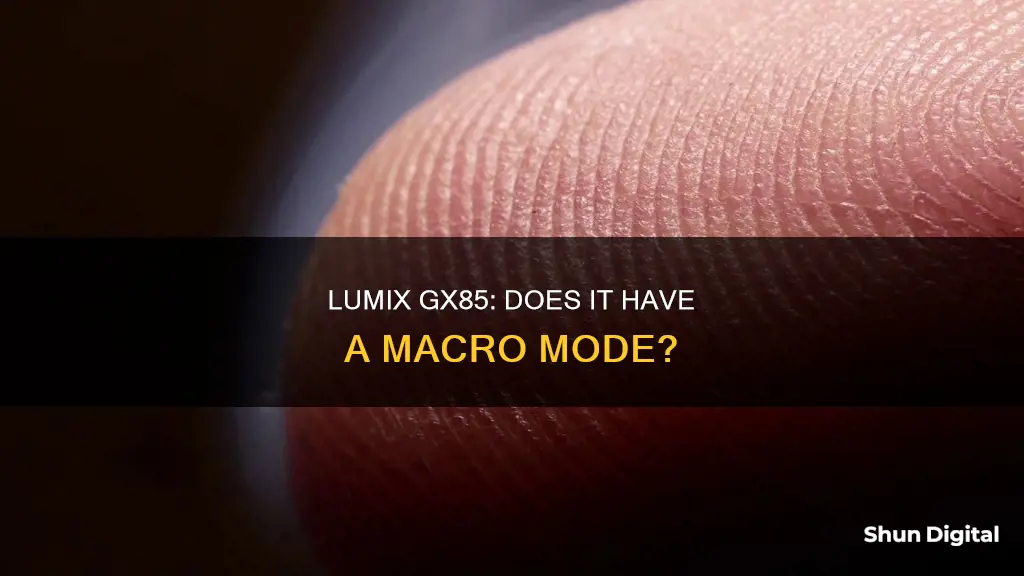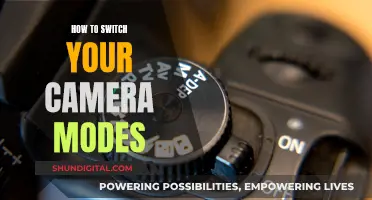
The Lumix GX85 camera does not have a macro mode, as the minimum focus distance is determined by the lens. However, there are several options for achieving macro photography with this camera. One option is to purchase a macro lens, such as the Olympus 60mm macro lens or the Panasonic 30mm macro lens. Another option is to use extension tubes with your existing lenses, which will allow you to focus closer and achieve greater magnification. Additionally, you can use diopters or close-up lenses, which are low-cost options that can be attached to your existing lenses to achieve greater magnification for macro photography.
| Characteristics | Values |
|---|---|
| Camera body | Interchangeable lens |
| Macro mode | Not available |
| Macro photography | Requires a macro lens or a set of extension tubes to use with existing lenses |
| Magnification | A true macro is 1:1 |
| Focus distance | Depends on the lens |
| Focus stacking | Available |
| Bracketing | Available |
What You'll Learn

The 12-32mm lens has a maximum reproduction ratio of 0.13x
The maximum reproduction ratio of a lens is the ratio of the size of the image of the subject on your sensor to the real size of the subject. In other words, it is the largest that you can make a subject on the film/sensor compared to its real-life size.
The maximum reproduction ratio is an important specification for macro photographers, as it determines how much of the frame you can fill with a tiny subject. The 12-32mm lens will not allow you to fill much of the frame with a small subject, as the ratio is quite low.
If you are interested in macro photography, you may want to consider investing in a dedicated macro lens, such as the Panasonic 30mm macro or the Olympus 60mm macro, which both offer a 1:1 reproduction ratio. These lenses will allow you to get much closer to your subject and capture more detail.
GoPro Charging Time: How Long Until Your Camera's Ready?
You may want to see also

The 14-140mm lens has a maximum magnification of 0.25x
This level of magnification is sufficient for capturing larger flowers and plants in full frame. It can also be used to get impactful close-ups of larger subjects, such as a flower cluster or stalks of wheat.
If you want to get even closer to your subject and achieve true macro shots, you would need a lens with a magnification of 1:1 or higher. However, keep in mind that the 14-140mm lens is still capable of producing impressive images, especially for nature and travel photography.
Get Camera Raw Plugin: Copy and Paste Guide
You may want to see also

The 45-150mm lens has a maximum magnification of 0.17x
The magnification of a lens is the ratio between an object's size when projected on a camera sensor and its size in the real world. The ratio is usually written as 1:5.88, or "one to five-point-eight-eight magnification". It can also be written in decimal form as 0.17x.
The magnification of a lens is a property of the lens itself and does not change with sensor size. However, using a crop sensor can make the subject appear larger in the final image, even though the magnification remains the same.
The 45-150mm lens's magnification is considered maximum because it occurs at the lens's closest focusing distance. The magnification of a lens varies with the distance to the object.
The High Cost of Camera Batteries: Why?
You may want to see also

The Panasonic Lumix DMC-GX85 has a mushy look due to noise reduction
The Panasonic Lumix DMC-GX85 is a mid-range interchangeable lens camera with a 16MP Four Thirds sensor and 4K video capability. It has a tilting touchscreen display, 5-axis image stabilization, and a bouncable pop-up flash. It also has a fast autofocus system and a large buffer. However, it does not have a microphone input and the screen cannot be turned forward for selfies.
To improve the image quality and reduce the mushy look, it is recommended to set the noise reduction feature to Low or Off. Additionally, shooting in RAW format will provide more control over the noise reduction process during post-processing.
Camera Battery Lifespan: How Long Does It Last?
You may want to see also

The Panasonic Lumix DMC-GX85 has a small EVF
The Panasonic Lumix DMC-GX85 is a compact and capable camera, offering a range of features for both beginners and advanced photographers. One aspect that stands out is its electronic viewfinder (EVF). While the camera has its strengths, the EVF is on the smaller side, which can be a drawback for some users.
The EVF on the Panasonic Lumix DMC-GX85 is indeed small, measuring approximately 0.7x magnification with a 17mm eye point. This means that the viewfinder image will appear smaller than on some other cameras, and users might find it less comfortable for extended periods of use. However, it's important to note that the EVF still offers a clear and detailed view, with a resolution of 2,764k dots, which is decent for a camera in this class.
The small EVF on the Panasonic Lumix DMC-GX85 might be a trade-off for its compact form factor. The camera body is designed to be lightweight and portable, making it ideal for travel and street photography. It's worth mentioning that the EVF still provides essential information, such as exposure settings and a level gauge, to assist photographers in getting the perfect shot.
While the small EVF might be a drawback for some, the Panasonic Lumix DMC-GX85 offers other features that make it a versatile camera. It has a tilting touchscreen, 4K video recording capability, and a variety of physical controls that allow for quick adjustments. Additionally, the camera's Micro Four Thirds lens mount provides access to a wide range of lenses, including macro lenses for close-up photography.
In conclusion, while the Panasonic Lumix DMC-GX85 has a small EVF, it remains a capable camera with a range of features that cater to both novice and experienced photographers. Its compact size, tilting screen, and 4K video capabilities make it a popular choice for those seeking a balance between portability and functionality.
Charging Your JVC GR-D850U Camera: Alternative Methods
You may want to see also
Frequently asked questions
The Lumix GX85 does not have a macro mode.
To do macro photography with the Lumix GX85, you need a macro lens or a set of extension tubes to use with your existing lenses.
The recommended macro lenses for the Lumix GX85 include the Oly 60 f/2.8, Panny 30, and the Oly 30.
Yes, you can use a dummy adapter with vintage macro lenses or an AF macro extension tube set.







